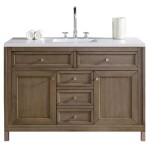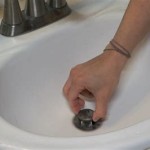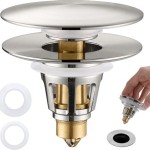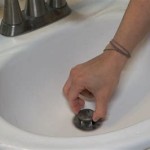Understanding Bathroom Sink Faucet Single Handles
Bathroom sink faucets are a fundamental element of any bathroom, providing the means for washing and personal hygiene. Among the various types of faucets available, single-handle faucets have gained considerable popularity due to their ease of use, modern aesthetic, and water-saving potential. This article aims to provide a comprehensive understanding of bathroom sink faucet single handles, covering their features, advantages, disadvantages, installation, maintenance, and factors to consider when selecting one.
A single-handle faucet, also known as a single-lever faucet, is characterized by a single lever or handle that controls both the water flow and temperature. Moving the handle up and down regulates the water flow, while moving it from side to side adjusts the temperature. This streamlined design contrasts with traditional two-handle faucets, where separate handles control hot and cold water. The single-handle mechanism offers a simplified user experience, making it a favored choice for many homeowners and commercial spaces.
Key Features of Single-Handle Bathroom Faucets
Single-handle bathroom faucets are distinguished by several key features that contribute to their functionality and aesthetic appeal. These features are important to consider when evaluating different models and determining the best fit for a particular bathroom.
Cartridge Design: The core of a single-handle faucet is the cartridge, which is responsible for mixing hot and cold water and controlling the flow rate. Cartridges are typically made of ceramic or plastic. Ceramic cartridges are generally more durable and resistant to wear and tear, providing a longer lifespan. Plastic cartridges are more cost-effective, but may require replacement more frequently. The cartridge's design influences the smoothness and precision of the water flow and temperature control.
Material Construction: The faucet body is typically constructed from solid brass, stainless steel, or zinc alloy. Brass is a highly durable and corrosion-resistant material, making it a popular choice for high-quality faucets. Stainless steel is another durable option that resists rust and corrosion. Zinc alloy is a more affordable alternative, but it may not be as durable as brass or stainless steel. The finish applied to the faucet body can also impact its durability and aesthetic appeal. Common finishes include chrome, brushed nickel, oil-rubbed bronze, and matte black.
Spout Design: The spout design influences the water flow pattern and the overall aesthetic of the faucet. Common spout designs include low-arc, high-arc, and gooseneck spouts. Low-arc spouts are typically compact and suitable for smaller sinks. High-arc spouts provide more clearance above the sink, making it easier to wash hands and fill containers. Gooseneck spouts offer a distinctive curved design that adds a touch of elegance to the bathroom. The spout reach, which is the horizontal distance from the faucet base to the center of the water stream, is also an important consideration for ensuring adequate coverage of the sink basin.
Water-Saving Features: Many single-handle bathroom faucets incorporate water-saving features to conserve water and reduce water bills. These features may include flow restrictors, which limit the maximum water flow rate, and aerators, which mix air with the water to create a larger, more forceful stream using less water. Faucets with the WaterSense label, certified by the Environmental Protection Agency (EPA), meet specific water efficiency criteria and can significantly reduce water consumption without compromising performance.
Installation Configuration: Single-handle bathroom faucets are typically designed for one-hole or three-hole installations. One-hole faucets are designed to be mounted on sinks with a single pre-drilled hole, while three-hole faucets require three holes for installation. If replacing an existing faucet, it is important to choose a faucet that is compatible with the existing sink configuration. Adapter plates are available to convert a three-hole sink to a one-hole installation, but this may affect the overall aesthetic of the sink.
Advantages and Disadvantages of Single-Handle Faucets
Single-handle bathroom faucets offer several advantages over traditional two-handle faucets, contributing to their widespread popularity. However, they also have certain disadvantages that should be considered before making a purchase.
Advantages:
Ease of Use: The single-handle design allows for easy control of both water flow and temperature with one hand. This is particularly convenient for individuals with limited mobility or when one hand is occupied. The intuitive lever operation simplifies the process of adjusting the water to the desired temperature, reducing the likelihood of scalding or excessively cold water.
Modern Aesthetic: Single-handle faucets generally have a sleek and modern design, which can enhance the overall aesthetic of the bathroom. Their clean lines and minimalist appearance complement contemporary bathroom styles. The availability of various finishes, such as chrome, brushed nickel, and matte black, allows for customization to match the existing bathroom decor.
Water-Saving Potential: Many single-handle faucets incorporate water-saving features, such as flow restrictors and aerators, which can significantly reduce water consumption. By limiting the maximum water flow rate, these features help to conserve water without sacrificing performance. The ability to quickly adjust the water temperature also reduces the amount of water wasted while waiting for the desired temperature to be reached.
Ease of Cleaning: The streamlined design of single-handle faucets typically makes them easier to clean than two-handle faucets. With fewer crevices and contours, there are fewer places for dirt and grime to accumulate. Regular cleaning with a mild soap and water solution is usually sufficient to maintain the faucet's appearance.
Disadvantages:
Potential for Temperature Fluctuations: Some users may experience slight temperature fluctuations with single-handle faucets, particularly when the water pressure changes or when multiple fixtures are used simultaneously. This is because the single cartridge is responsible for mixing both hot and cold water, and any changes in water pressure can affect the mixing ratio. However, this issue is less common with higher-quality faucets that incorporate advanced cartridge designs.
Repair Complexity: Repairing a single-handle faucet may be more complex than repairing a two-handle faucet, as the cartridge contains multiple components that can wear out or fail over time. Replacing the cartridge typically requires disassembling the faucet and removing the old cartridge. While DIY repair is possible, it may be necessary to consult a professional plumber for more complex issues.
Higher Initial Cost: Single-handle faucets are often more expensive than traditional two-handle faucets, particularly those with advanced features or high-quality construction. The upfront cost may be a deterrent for some buyers, but the long-term benefits, such as water savings and durability, can offset the initial investment.
Installation and Maintenance of Single-Handle Faucets
Proper installation and regular maintenance are essential for ensuring the longevity and optimal performance of single-handle bathroom faucets. Following the manufacturer's instructions and performing routine maintenance can help prevent leaks, corrosion, and other common problems.
Installation:
Preparation: Before installing a new faucet, it is important to shut off the water supply to the sink and disconnect the old faucet. Gather all the necessary tools and materials, including a basin wrench, adjustable wrench, screwdriver, plumber's putty, and Teflon tape. Review the manufacturer's instructions carefully to understand the specific installation procedures for the particular faucet model.
Mounting the Faucet: Position the faucet on the sink, ensuring that it is properly aligned with the sink holes. Apply plumber's putty to the base of the faucet to create a watertight seal. Secure the faucet to the sink using the mounting hardware provided, tightening the nuts and screws evenly to prevent damage to the sink or faucet.
Connecting the Water Supply Lines: Connect the hot and cold water supply lines to the faucet, using Teflon tape to seal the threads and prevent leaks. Tighten the connections securely, but avoid over-tightening, which can damage the supply lines or faucet fittings. Turn on the water supply slowly and check for leaks around the connections. If any leaks are detected, tighten the connections further or reapply Teflon tape.
Testing the Faucet: Once the faucet is installed and the water supply is connected, test the faucet to ensure that it is functioning properly. Check the water flow and temperature, and look for any leaks around the faucet base or spout. Adjust the handle to ensure smooth and easy operation. If any problems are encountered, consult the manufacturer's instructions or contact a professional plumber for assistance.
Maintenance:
Regular Cleaning: Clean the faucet regularly with a mild soap and water solution to remove dirt, grime, and water spots. Avoid using abrasive cleaners or scouring pads, which can damage the faucet finish. Use a soft cloth or sponge to clean the faucet, and rinse thoroughly with water. Dry the faucet with a clean towel to prevent water spots.
Leak Prevention: Check the faucet regularly for leaks around the base, spout, and handle. If any leaks are detected, tighten the connections or replace any worn-out parts, such as O-rings or washers. Promptly addressing leaks can prevent water damage and conserve water.
Cartridge Replacement: The faucet cartridge may need to be replaced periodically, depending on the water quality and usage frequency. Signs of a failing cartridge include dripping, leaking, or difficulty controlling the water flow or temperature. Replacing the cartridge typically involves disassembling the faucet and removing the old cartridge. Consult the manufacturer's instructions or a professional plumber for assistance.
Aerator Cleaning: The aerator, which is located at the tip of the spout, can become clogged with mineral deposits or debris over time. This can reduce the water flow and affect the water pressure. Remove the aerator and clean it with a small brush or soak it in vinegar to dissolve mineral deposits. Reinstall the aerator after cleaning.
Winterization: In cold climates, it is important to protect the faucet from freezing temperatures, which can cause pipes to burst and damage the faucet. Insulate the pipes and faucet with foam insulation or heat tape. If the bathroom is not heated, shut off the water supply to the faucet and drain the pipes to prevent freezing.

Delta Foundations Centerset Bathroom Sink Faucet

Waterfall Single Handle Bathroom Faucet With Metal Pop Up Drain Sink Matte Black In Hh0302bd

Juno Dolphin Black Single Handle Bathroom Sink Faucet

Single Handle Hole Bathroom Faucet With Rotating Spout Brass Modern Sink Basin Faucets In Matte Black

Zalerock Arc Waterfall Single Handle Hole Bathroom Faucet In Black H02lttm053d The Home

Moen Avri Spot Resist Brushed Nickel Single Hole 1 Handle Watersense Bathroom Sink Faucet With Drain And Deck Plate 84156srn

Single Handle Classic And Modern Bathroom Faucets

Cölm Unique Design Basin Bathroom Sink Faucet Single Handle Hole

Moen Avri Matte Black Single Hole 1 Handle Watersense High Arc Residential Bathroom Sink Faucet With Drain Deck Plate 84156bl

Delta Foundations 4 In Centerset Single Handle Bathroom Faucet Brushed Nickel B510lf Ssppu Eco The Home







